Famed for its stunning natural beauty, rich history, and vibrant cultural scene, Cape Town is a destination that captures hearts. Tucked at the base of Table Mountain and surrounded by pristine beaches, this South African city has a kaleidoscope of attractions. This article journeys through some of the best places to visit in Cape Town, offering a glimpse into the city’s soul.
Table Mountain
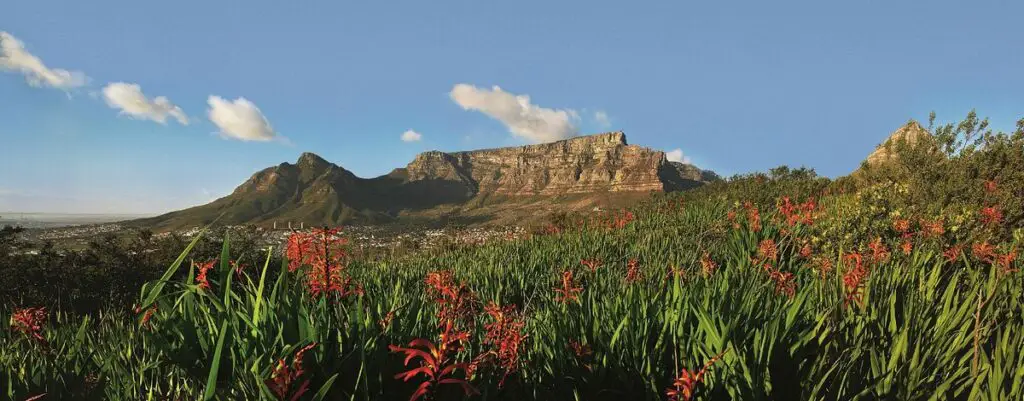
Table Mountain, a prominent landmark in Cape Town, South Africa, stands tall at 1,085 meters above sea level, providing a picturesque backdrop to the city. This flat-topped mountain, part of the Table Mountain National Park, is a natural marvel and a notable tourist attraction.
The mountain gets its name from its flat top, which creates an impressive plateau stretching approximately 3 kilometers from side to side. The plateau is flanked by the famous Devil’s Peak to the east and by Lion’s Head to the west, creating a dramatic natural amphitheater over the city of Cape Town.
The mountain is not only rich in flora but also fauna. It’s home to various small animals like porcupines, mongooses, snakes, and the Table Mountain Ghost Frog, a species found nowhere else in the world. Birdwatchers will be delighted by the diversity of avian species, including birds of prey like the Peregrine Falcon and the African Harrier-Hawk.
Table Mountain offers numerous activities for nature enthusiasts. There are well over 350 paths to the summit, providing options for both leisurely hikers and more adventurous climbers. Abseiling is another popular activity, offering thrill-seekers a unique perspective of the city.
For those who prefer a less strenuous route to the top, the Table Mountain Aerial Cableway provides an exciting ride, taking visitors up to the summit in rotating cable cars. The journey offers a 360-degree view of the city, including vistas of Robben Island in the Atlantic Ocean and the sprawling cityscape of Cape Town.
Robben Island
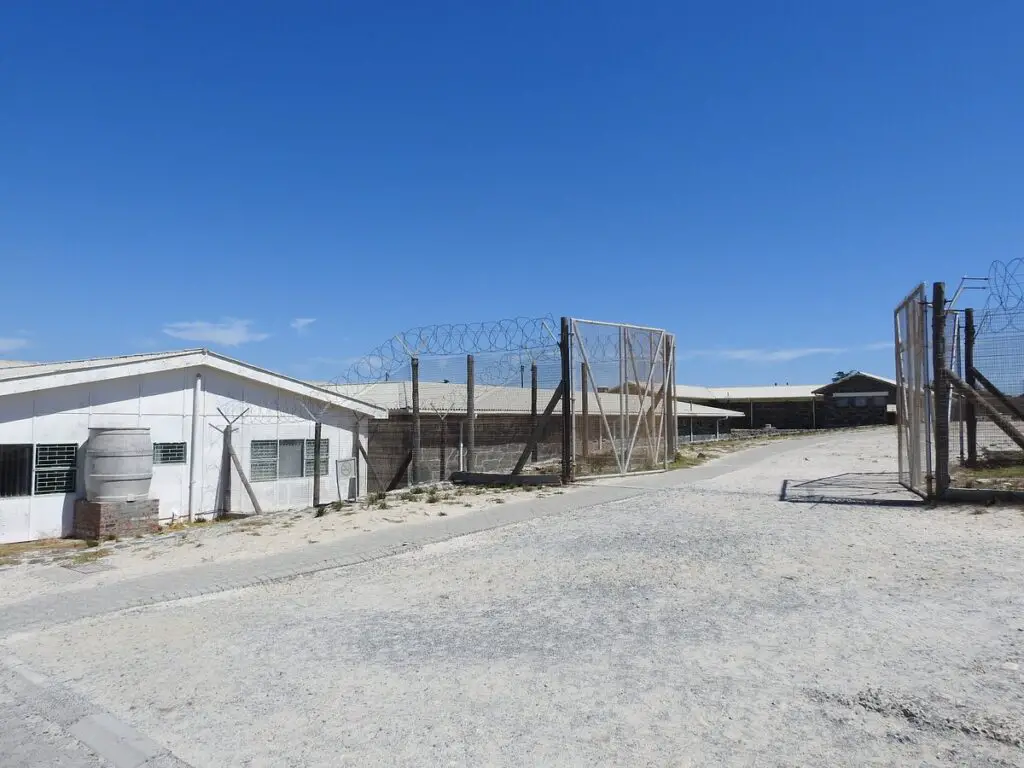
Robben Island, located just off the coast of Cape Town, South Africa, is a place of profound historical and emotional significance. Named a UNESCO World Heritage Site in 1999, this isolated island served as a place of banishment and imprisonment for nearly four centuries.
The name “Robben Island” translates to “Seal Island” in Dutch, a reference to the seals that once populated its shores. Despite its relatively small size—only around 5.07 square kilometers—the island’s history is extensive and complex.
Robben Island is perhaps best known as a political prison during apartheid, South Africa’s period of institutionalized racial segregation that lasted from 1948 to 1994. The island’s most famous prisoner, Nelson Mandela, spent 18 of his 27 years in prison there. Other prominent anti-apartheid activists, including Walter Sisulu and Ahmed Kathrada, were also imprisoned on Robben Island.
In addition to its function as a prison, Robben Island served various other purposes over the centuries. It was a training and defense station in World War II and a hospital for people with leprosy and other chronic illnesses. The island also served as an asylum for the mentally ill.
Today, Robben Island is a public museum, accessible to tourists who can ferry across from the mainland. The museum operates as a poignant reminder of the struggle against apartheid. Visitors can tour the former prison buildings, including the maximum-security prison where Nelson Mandela was held. The tours are often led by former political prisoners, providing firsthand accounts of the harsh conditions and the prisoners’ indomitable spirit.
The island also houses a variety of bird species and is a breeding ground for African penguins. The vegetation on the island is primarily made up of hardy shrubs and grasses that can withstand the harsh, windswept conditions.
Notably, Robben Island has become a symbol of triumph over adversity. It represents a critical chapter in the country’s path to democracy, making it an essential visit for those who want to understand South Africa’s complex history. The lessons of resilience, freedom, and the human spirit that Robben Island teaches continue to resonate with people worldwide.
Cape Point & Cape of Good Hope
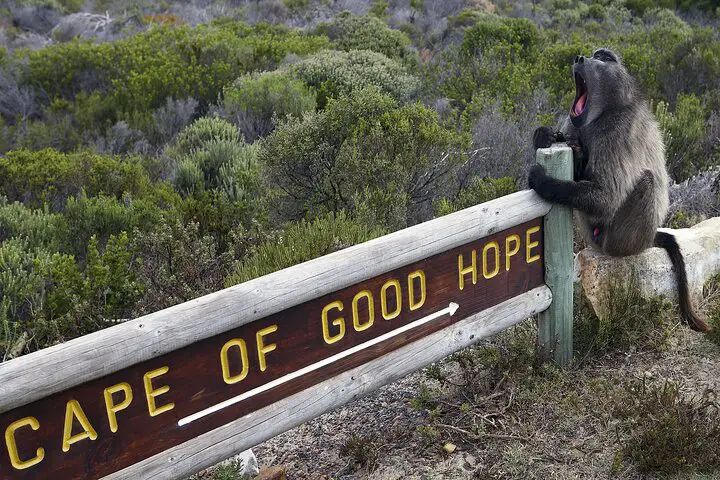
The Cape of Good Hope is a rocky headland located on the Atlantic coast of the Cape Peninsula in South Africa. Renowned for its stunning natural beauty and historical significance, it’s a popular destination for both local and international tourists.
The name Cape of Good Hope was given by Portuguese explorer Bartolomeu Dias in 1488. It was originally known as the Cape of Storms due to the treacherous seas encountered by early sailors. Later, King John II of Portugal renamed it Cape of Good Hope (Cabo da Boa Esperança) to signify the opening of a route to the east.
Geographically, contrary to a common misconception, the Cape of Good Hope is not the southernmost point of Africa. That distinction goes to Cape Agulhas, about 150 kilometers to the southeast. However, the Cape of Good Hope is a significant landmark as it marks a significant waypoint for ships journeying between Europe and the East via the Cape route.
The Cape of Good Hope is part of the Table Mountain National Park, a biodiversity hotspot that houses numerous endemic flora and fauna. The rich plant life includes the unique Cape Fynbos, a vegetation type found only in the Cape Floristic Region. The seas off the Cape are also teeming with marine life, including seals, great white sharks, and several species of whales that can be seen during the migration season.
Animal lovers will enjoy spotting the various creatures that call this area home, such as baboons, antelope, and over 250 species of birds, including African Penguins, which can be seen at nearby Boulders Beach.
The Cape of Good Hope offers a variety of activities for visitors. One can enjoy numerous walking and hiking trails that crisscross the landscape, offering stunning views of the cliffs and the ocean. A visit to the old Cape Point lighthouse, accessible via a funicular railway, is a must, offering spectacular vistas of the rugged coast.
One of the most captivating experiences at the Cape of Good Hope is simply standing at the rocky headland, looking out over the sea, knowing there’s nothing but vast ocean until Antarctica. It’s a place of wild beauty, teeming with life, and steeped in history.
The Cape of Good Hope, with its awe-inspiring landscapes and rich biodiversity, remains a key destination in South Africa, a place where one can truly feel at the edge of the continent.
V&A Watersport

The Victoria & Alfred (V&A) Waterfront, named after Queen Victoria and her son Alfred, is one of the most visited destinations in Cape Town, South Africa. Located at the foot of Table Mountain and on the edge of the Atlantic Ocean, the V&A Waterfront offers a unique blend of natural beauty, rich history, and exciting shopping and dining experiences.
The Waterfront boasts over 450 retail outlets, from international brands to unique local crafts, making it a shopper’s paradise. The Watershed, for example, is the go-to place for African arts, crafts, and design, hosting over 150 traders who specialize in handmade goods.
The food and drink scene at the V&A Waterfront is equally diverse and compelling, with a variety of restaurants, cafes, and bars offering a range of culinary experiences. From local South African cuisine to international delicacies, there’s a flavor for every palate. Not to mention the fantastic views of the harbor and mountain that accompany your meal.
The V&A Waterfront is also a hub of entertainment and leisure activities. The Two Oceans Aquarium, home to more than 8000 marine animals, is a family favorite, showcasing the rich diversity of the Indian and Atlantic Oceans. The Cape Wheel offers a unique perspective of Cape Town, providing panoramic views of the city from its observation cabins.
The V&A Waterfront is steeped in history, with several historical landmarks within its precinct. The Clock Tower, originally the port captain’s office, is a notable Victorian Gothic-style building, and the nearby Chavonnes Battery showcases the archaeological ruins of a Dutch East India Company fort.
Moreover, the Waterfront is the departure point for tours to Robben Island. The Robben Island Museum and ferry embarkation building offer exhibits about the island’s history and the political prisoners, including Nelson Mandela, who were incarcerated there.
For art enthusiasts, the Zeitz Museum of Contemporary Art Africa (MOCAA) is an absolute must-visit. Housed in a converted grain silo, it features the largest collection of contemporary African art in the world.
Adding to the appeal of the V&A Waterfront is its commitment to sustainable development. It’s been recognized for its efforts towards reducing energy consumption, water savings, waste recycling, and social empowerment.
Boulders Beach
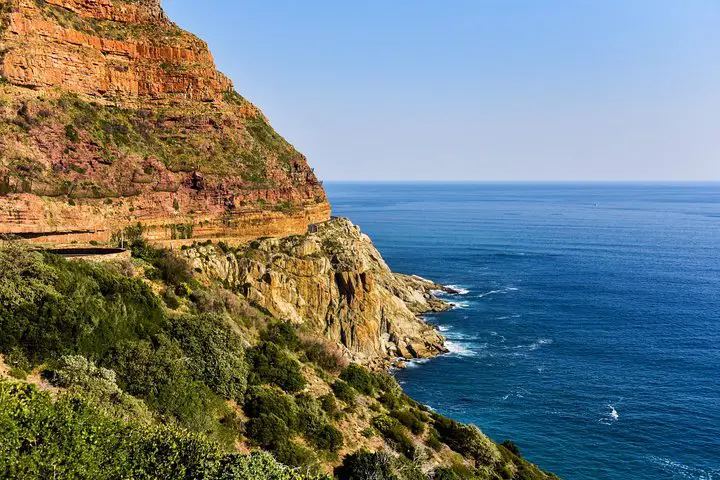
Boulders Beach is one of the most visited beaches in Cape Town, South Africa, and for a very good reason. It is one of the few places in the world where you can get up close to African penguins in their natural habitat.
Located in the charming coastal town of Simon’s Town, Boulders Beach forms part of the Table Mountain National Park. The beach gets its name from the inlets between large granite boulders from which it’s formed. These boulders, some over 540 million years old, not only give the beach its name but also provide sheltered ‘private’ spots, making it a great location for picnics and sunbathing.
However, the real stars of Boulders Beach are its resident African penguins, previously known as Jackass penguins due to their distinctive donkey-like braying sound. The penguins began colonizing the beach in the early 1980s, and the colony has grown to over 2000 birds since then. The birds are relatively unbothered by human presence, giving visitors a unique opportunity to observe these endearing creatures as they waddle around, swim in the ocean, and tend to their young. A series of wooden walkways has been built to allow visitors to view the penguins without disturbing them.
While the penguins are the main attraction, the beach itself is beautiful, with clear turquoise water that, while a bit chilly, is perfect for a refreshing dip. The massive boulders not only create a stunning backdrop but also serve as wind shelters, making the beach a lovely sunbathing spot. Snorkeling is also popular, with the boulders creating interesting underwater landscapes.
It’s worth noting that Boulders Beach is a protected area, meaning visitors are not allowed to touch or feed the penguins. These rules are in place to ensure the penguins’ habitat remains undisturbed and the birds can continue to thrive.
In addition to its natural attractions, Boulders Beach is close to Simon’s Town, which is worth a visit for its historical sites, charming architecture, and good restaurants.
Boulders Beach is truly a unique destination. Not many places offer the opportunity to share your sunbathing spot with a colony of penguins. It’s a fun, relaxed, and thoroughly unique experience that visitors to Cape Town shouldn’t miss.
Constantia Vineyards
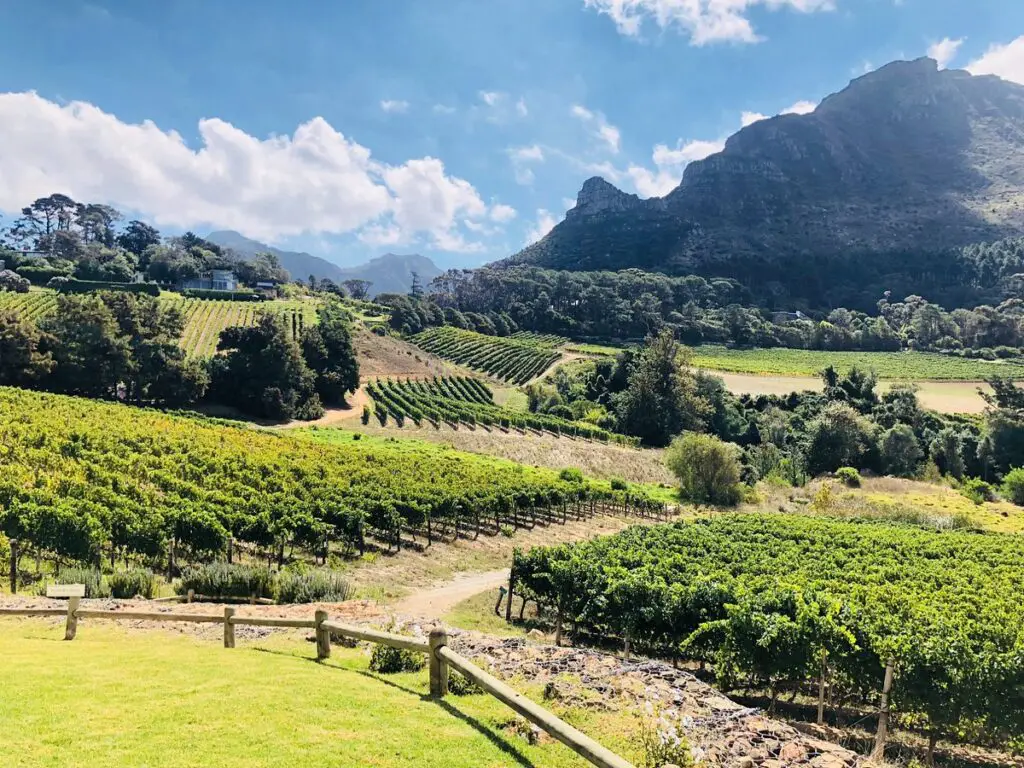
Constantia Vineyards, nestled in the fertile Constantia Valley, is an integral part of South Africa’s rich wine-making history. As the oldest wine-producing region in the southern hemisphere, Constantia offers a unique blend of centuries-old estates and modern, boutique wineries, making it a must-visit for any wine lover.
The history of Constantia vineyards dates back to 1685 when the Governor of the Cape, Simon van der Stel, established a farm in the valley, now known as Groot Constantia. Groot Constantia is the oldest wine estate in South Africa and has been producing wine continuously since its inception. Its historic Cape Dutch Manor House, ancient wine cellars, and beautiful vineyards attract visitors from around the world.
Over the centuries, the Constantia Valley has been divided and subdivided, resulting in several unique wine estates, each with its own distinct charm. These include Klein Constantia, Buitenverwachting, Constantia Uitsig, and Steenberg Vineyards, among others.
The region is renowned for its production of high-quality cool-climate wines, particularly its award-winning Sauvignon Blancs and the famous Vin de Constance. Vin de Constance, a sweet dessert wine, was much loved by European nobility in the 18th and 19th centuries and was even mentioned in the works of Charles Dickens and Jane Austen.
Visitors to the Constantia vineyards can partake in guided vineyard tours, where they learn about the history of the estate, the wine-making process, and the unique terroir of the region. This is typically followed by a wine tasting session, where guests can sample a range of the estate’s wines, from robust reds to crisp whites and luscious dessert wines.
In addition to wine-related activities, most vineyards in Constantia boast top-tier restaurants, offering a gastronomic experience that pairs perfectly with their wines. Some estates also offer picnic baskets that can be enjoyed on their manicured lawns amidst the vineyards.
The Constantia Wine Route, as it’s often referred, is located just a 15-minute drive from the Cape Town city center, making it an easily accessible day trip. Its stunning scenery, historic architecture, world-class wines, and fine dining make it an unforgettable experience.
In conclusion, a visit to the Constantia vineyards is not just about wine. It’s about stepping back in time, savoring the breathtaking views of the Constantia Valley, and enjoying the fruits of a terroir that has been carefully cultivated for over three centuries. Whether you’re a seasoned oenophile or a casual wine enthusiast, the Constantia vineyards have something to offer you.
Bo-Kaap
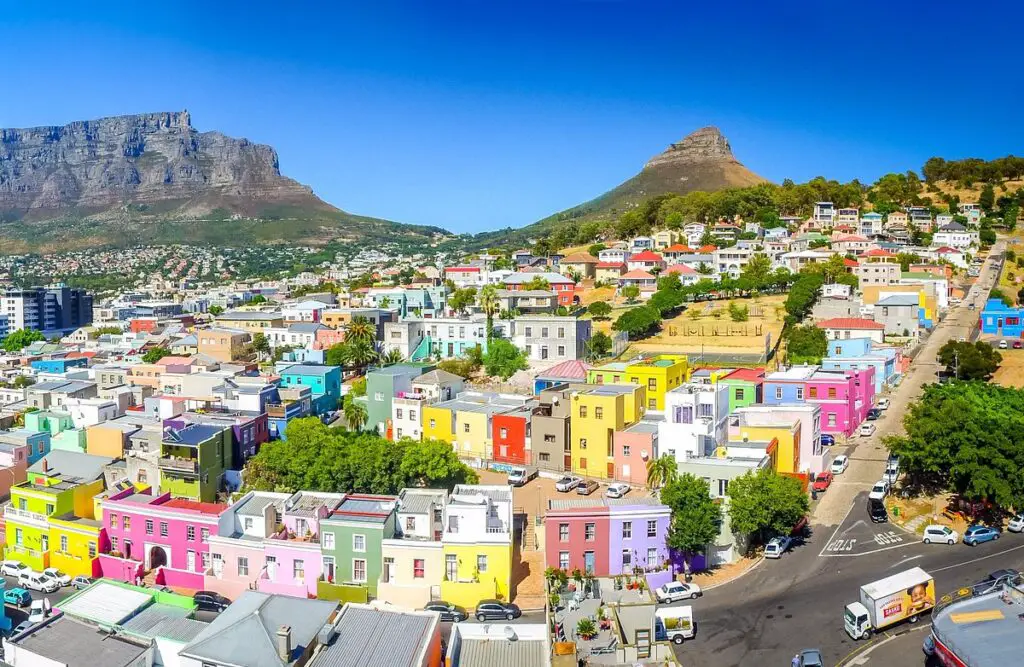
The Bo-Kaap, meaning “Above Cape” in Afrikaans, is one of the most colorful and culturally significant neighborhoods in Cape Town, South Africa. It’s located on the slopes of Signal Hill, above the city center, and is famed for its bright, multicolored houses, cobbled streets, and distinctive Cape Malay culture.
The history of Bo-Kaap dates back to the 16th and 17th centuries when the Dutch brought slaves, political exiles, and prisoners from Malaysia, Indonesia, and other parts of Africa to the Cape. These people, known as Cape Malays, have had a profound influence on the culture, cuisine, language, and architecture of the Bo-Kaap.
The vividly painted houses are one of the most recognizable features of the Bo-Kaap. The tradition of painting houses in bright colors is said to have begun as an act of rebellion when slaves were allowed to buy their own houses and expressed their freedom through bold, vibrant colors.
Bo-Kaap is also known for its Cape Dutch and Cape Georgian architectural styles. Its narrow, cobbled streets are lined with flat-roofed, single-story homes with an emphasis on the front façade, showcasing beautiful doors and windows with intricate fanlights.
The Bo-Kaap is a place of rich cultural heritage. Its residents have preserved their unique Cape Malay culture through traditions, cuisine, and the practice of Islam. You can find numerous mosques scattered throughout the area, with the Auwal Mosque, the oldest mosque in South Africa, being located here.
Cuisine is a significant part of the Bo-Kaap’s cultural heritage. Traditional Cape Malay cuisine is a fusion of Eastern and Western flavors, known for its use of spices. Visitors can partake in cooking classes and enjoy traditional dishes like bobotie (a spiced, baked minced meat dish), breyani (spiced rice dish), and koeksisters (sweet, syrup-coated doughnut).
District Six Museum

The District Six Museum, located in Cape Town, South Africa, is a place of great historical importance and emotional resonance. It serves as a poignant memorial to the forced movement of 60,000 inhabitants of various races from District Six during Apartheid in the 1970s.
District Six was a vibrant multi-racial, multi-cultural community located near the heart of Cape Town. However, in 1966, it was declared a “white area” under the Group Areas Act of 1950 by the Apartheid government, and all non-white residents were evicted and their homes demolished.
The District Six Museum, established in 1994, works to preserve the memories of this forcibly removed community. Housed in a restored Methodist church, the museum displays an impactful array of exhibits that tell the story of District Six and its residents.
One of the museum’s most notable features is a large-scale floor map of District Six, onto which former residents have handwritten notes and annotations. These notes include their names, the places where they lived, and personal anecdotes or stories. The map brings to life the sense of community that once existed and the personal tragedies that the eviction caused.
Photographs, paintings, personal narratives, and historical documents are also on display, presenting a vivid picture of life in District Six before the removals. One can explore exhibits detailing the district’s diverse community, its music and culture, and the political and social forces that led to its destruction.
A key part of the museum’s work involves projects that promote reconciliation, reconstruction, and cultural revival. It hosts a variety of workshops, storytelling sessions, and education programs to encourage former residents and their descendants to reconnect with their heritage.
One unique feature of the museum is that it is often staffed by former residents of District Six, known as “memory anchors.” These individuals are available to share their personal experiences and stories with visitors, adding an intensely personal and human element to the museum experience.
Visiting the District Six Museum provides a deeply moving insight into a painful period of South Africa’s history. However, it also highlights the resilience of the human spirit, the power of memory and community, and the ongoing struggle for social justice and equality. It’s an essential visit for anyone wanting to understand the complexities of South Africa’s past and its influence on the present day.


